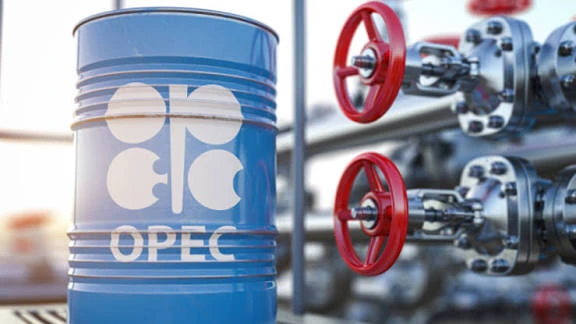LONDON — OPEC+ has agreed to raise oil production by a modest 137,000 barrels per day (bpd) beginning in November, maintaining the same gradual pace as October, according to three sources familiar with the decision.
The move underscores the group’s cautious approach amid competing pressures from leading members Saudi Arabia and Russia, fluctuating global demand, and ongoing geopolitical uncertainty.
The decision, reached ahead of an online ministerial meeting Sunday, highlights persistent divisions within the Organization of the Petroleum Exporting Countries and its allies (OPEC+) over how aggressively to restore output after years of coordinated cuts.
The OPEC+ alliance, which includes the 13 OPEC members plus Russia and several smaller producers, has spent much of 2024 and 2025 gradually rolling back record production cuts introduced during the COVID-19 pandemic.
So far this year, the group has raised output targets by more than 2.6 million bpd, representing about 2.5 percent of global oil demand, in an effort to regain market share lost to competitors such as US shale producers.
OPEC+ output cuts peaked in March at 5.85 million bpd, made up of three layers 2.2 million bpd in voluntary cuts, 1.65 million bpd from eight members, and 2 million bpd shared across the group.
The alliance began unwinding those cuts in stages, with October’s modest 137,000 bpd increase marking the first step in removing the second layer.
Today’s decision reflects a compromise between maintaining market stability and responding to recovering demand, one OPEC delegate said following Sunday’s meeting.
Energy analysts view the latest increase as a signal that OPEC+ intends to avoid disrupting oil prices, which have hovered between $82 and $87 per barrel in recent weeks.
“Russia is under pressure from Western sanctions that limit its ability to ramp up production,” said Dr. Lina Al Faraj, senior energy economist at the Gulf Policy Institute in Riyadh. “A modest increase helps Moscow preserve revenue while avoiding an oversupply that could drag prices down.”
In contrast, Saudi Arabia has pushed for larger hikes up to 548,000 bpd arguing that global consumption remains robust and that maintaining high prices risks ceding market share.
The kingdom sees steady demand from Asia and wants to ensure it remains a reliable supplier, said Khalid Rahman, oil markets strategist at Energy Link Advisors.
But it also knows that pushing too fast could cause friction with partners still constrained by sanctions or capacity issues.
The latest production boost brings OPEC+ output closer to pre-pandemic levels, though still below the highs of 2019.
Year OPEC+ Output Cuts Net Increase Global Demand Share
- 2023 — 5.85 million bpd
- 2024 — 1.8 million bpd 1.7%
- 2025 — 2.6 million bpd 2.5%
The incremental approach contrasts sharply with the United States, where shale producers have ramped up drilling amid favorable prices.
US output is projected to rise by 500,000 bpd by year’s end, according to the Energy Information Administration (EIA).
This cautious strategy shows OPEC+ is prioritizing price stability over rapid expansion, said Marc Delaney, senior oil analyst at GlobalCommodities. “They’re watching demand signals from China and Europe very closely.”
In oil dependent economies across the Middle East and Africa, the decision has drawn mixed reactions.
In Iraq, which has struggled to meet its output quotas due to infrastructure challenges, officials welcomed the steady pace.
“We need time to rebuild capacity before taking on larger targets,” said Ahmed Karim, deputy director at Iraq’s Ministry of Oil. “This approach gives us breathing room.”
However, in Nigeria, where output has lagged due to theft and sabotage, energy workers expressed frustration.
Every barrel counts for our economy, said Chinedu Okoro, a technician at a Port Harcourt refinery. “A slow increase means fewer jobs and slower recovery for our communities.”
Consumers remain wary of potential price volatility. “Fuel prices here have been unpredictable,” said Maya Hassan, a taxi driver in Cairo. “Even small changes in global supply affect us immediately.”
OPEC+ is expected to review production levels again in December, with further adjustments likely depending on demand trends and geopolitical developments.
Analysts say the alliance faces a delicate balancing act heading into 2026, as slowing global growth and energy transitions weigh on long term oil forecasts.
Emerging economies are still driving demand, but the pace is uneven, said Dr. Al-Faraj. “OPEC+ must remain agile to prevent either shortages or gluts.”
The group also continues to navigate political pressures. Western nations have urged producers to expand output more rapidly to ease inflation, while member states dependent on oil revenues seek to preserve fiscal stability.
By opting for another 137,000 bpd increase in November, OPEC+ reaffirmed its cautious stance balancing diverging member interests, sanctions constraints, and uncertain global demand.
The move underscores the alliance’s focus on market stability over aggressive expansion, setting the stage for further debate in the months ahead.
Whether this gradual path sustains price equilibrium or invites renewed competition from non OPEC producers will depend on how swiftly the global economy rebounds in late 2025.

